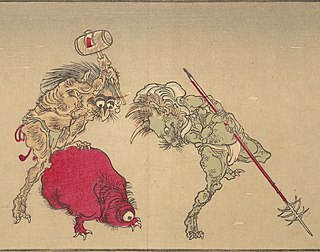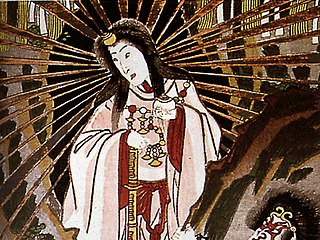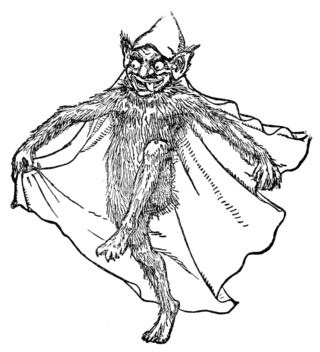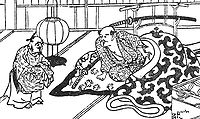
In English folklore, The Puck, also known as Goodfellows, are demons or fairies which can be domestic sprites or nature sprites.

A fairy is a type of mythical being or legendary creature, generally described as anthropomorphic, found in the folklore of multiple European cultures, a form of spirit, often with metaphysical, supernatural, or preternatural qualities.

A leprechaun is a diminutive supernatural being in Irish folklore, classed by some as a type of solitary fairy. They are usually depicted as little bearded men, wearing a coat and hat, who partake in mischief. In later times, they have been depicted as shoe-makers who have a hidden pot of gold at the end of the rainbow.
Japanese folktales are an important cultural aspect of Japan. In commonplace usage, they signify a certain set of well-known classic tales, with a vague distinction of whether they fit the rigorous definition of "folktale" or not among various types of folklore. The admixed impostors are literate written pieces, dating back to the Muromachi period or even earlier times in the Middle Ages. These would not normally qualify for the English description "folktales".

Yōkai are a class of supernatural entities and spirits in Japanese folklore. The kanji representation of the word yōkai comprises two characters that both mean "suspicious, doubtful", and while the Japanese name is simply the Japanese transliteration or pronunciation of the Chinese term yaoguai, some Japanese commentators argue that the word yōkai has taken on multiple different meanings particular to a Japanese context, including referring to a large number of uniquely Japanese creatures.

A pixie is a mythical creature of British folklore. Pixies are speculated to be particularly concentrated in the high moorland areas around Devon and Cornwall, suggesting some Celtic origin for the belief and name. However, the word 'pixie' also appears in Dorset, Somerset and to a lesser extent in Sussex, Wiltshire and Hampshire.

A bugbear is a legendary creature or type of hobgoblin comparable to the boogeyman, and other creatures of folklore, all of which were historically used in some cultures to frighten disobedient children.

A kappa—also known as kawatarō, komahiki, with a boss called kawatora or suiko—is a reptiloid kami with similarities to yōkai found in traditional Japanese folklore. Kappa can become harmful when they are not respected as gods. They are typically depicted as green, human-like beings with webbed hands and feet and turtle-like carapaces on their backs. A depression on its head, called its "dish" (sara), retains water, and if this is damaged or its liquid is lost, the kappa is severely weakened.

Japanese mythology is a collection of traditional stories, folktales, and beliefs that emerged in the islands of the Japanese archipelago. Shinto traditions are the cornerstones of Japanese mythology. The history of thousands of years of contact with Chinese and various Indian myths are also key influences in Japanese religious belief.
A sprite is a supernatural entity in European mythology. They are often depicted as fairy-like creatures or as an ethereal entity.

Yaoguai are a class of creatures in Chinese mythology, folk tales, and literature that are defined by their supernatural abilities and by being strange, uncanny or weird. A popular translation for them in Western texts is simply "demon", but this label can be very misleading, demons in the religious sense are termed "mo" (魔) rather than "yao" (妖). Other translations include "fiend", "monster", "goblin", "evil spirit" or "bogeyman". These creatures blur the boundaries between the natural and the unnatural, the human and the non-human, and their appearance in tales is often related to political portents or as a reflection of the social and cosmopolitical order.
In Japanese folklore, tsukumogami are tools that have acquired a kami or spirit. According to an annotated version of The Tales of Ise titled Ise Monogatari Shō, there is a theory originally from the Onmyōki (陰陽記) that foxes and tanuki, among other beings, that have lived for at least a hundred years and changed forms are considered tsukumogami. In modern times, the term can also be written 九十九神, to emphasize the agedness.

A lutin is a type of hobgoblin in French folklore and fairy tales. Female lutins are called lutines.
Mythic humanoids are legendary, folkloric, or mythological creatures that are part human, or that resemble humans through appearance or character. Each culture has different mythical creatures that come from many different origins, and many of these creatures are humanoids. They are often able to talk and in many stories they guide the hero on their journey.

A goblin is a small, grotesque, monstrous creature that appears in the folklore of multiple European cultures. First attested in stories from the Middle Ages, they are ascribed conflicting abilities, temperaments, and appearances depending on the story and country of origin, ranging from mischievous household spirits to malicious, bestial thieves. They often have magical abilities similar to a fairy or demon, such as the ability to shapeshift.
A water spirit is a kind of supernatural being found in the folklore of many cultures:
The Kijimuna, or Bunagaya, are creatures of the mythology native to the island of Okinawa. They are said to look around three or four years old and have red hair.

The Miyoshi Mononoke Museum, also known as the Yumoto Koichi Memorial Japan Yōkai Museum, or shortened to the Yōkai Museum, is located in Miyoshi, Hiroshima Prefecture, Japan. The museum collection holds over 5,000 artworks and objects that represent yōkai, supernatural beings in Japanese folklore.











